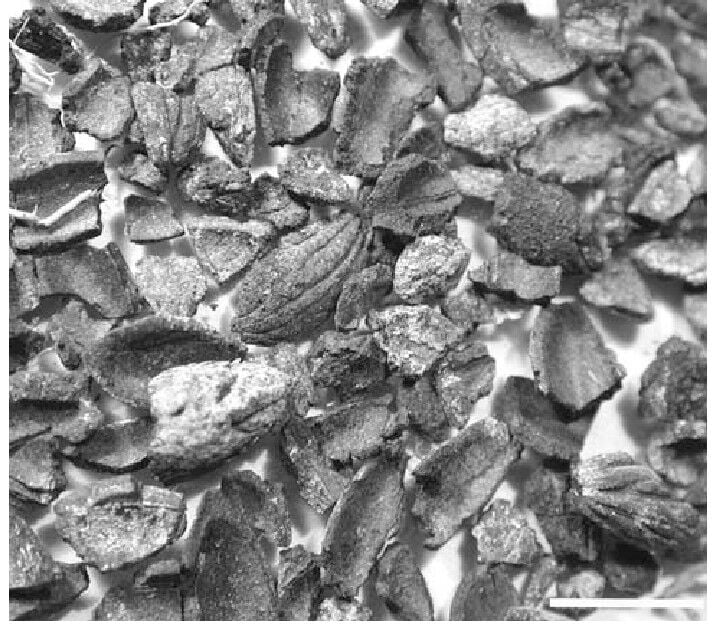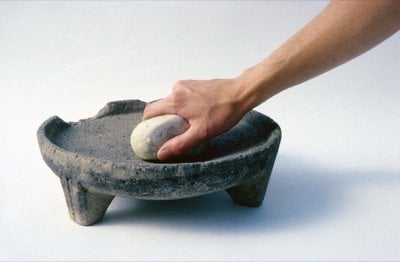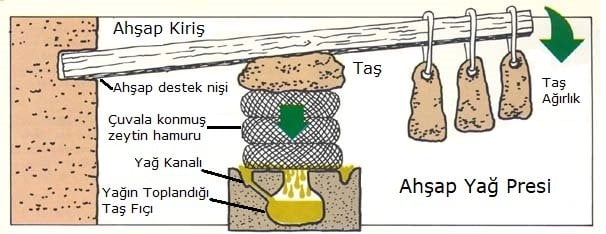Olive Oil Culture History I - Ancient Times
15-04-2025
11:09

Photo; Remains of crushed olive pits preserved in a carbonized state, Early Bronze Age (3500-2000 BC) archaeological site at Tel Yarmouth, Israel, experts believe from the appearance of the residue that the olives were used as fuel after pressing.
In the analyses (gas chromatography and mass spectrometry) conducted to find out what organic molecules were in the paint content of the Magdalenian cave paintings in Fontanet Cave belonging to the Paleolithic period (12-17 thousand BC), residues of vegetable fatty acid molecules were found. It is not known whether the oil used is from wild olives, because the origins of the oils could not be determined due to their decomposition.
Rescue excavations were carried out in the Ein Zippori archaeological site of Isaril between 2011 and 2013 prior to the construction of the highway. Analysis of ceramics unearthed revealed that olive oil was used in the region in the early Chalcolithic Age (Copper/Stone Age, 5000-3000 BC). Organic residues in ceramic vessels made of clay date back to 5800 BC. There is no evidence of which type of olives – wild or domesticated – people in the region used to obtain the oil or for what purpose they used the olive oil.
The remains of primitive olive oil works date back to 3500 BC. It has been understood that olive oil was obtained by crushing and pressing olives in rock cavities (olive crushing pits) or stone mortars on the island of Crete, which dates back to 3000 BC.
It is estimated that primitive olive pressing techniques - probably based on arm and leg strength - have been used from olives collected from wild olive trees since the Neolithic and Bronze Ages (9000 BC and later) in the Middle East, where the olive tree was first domesticated and cultivated. We do not have archaeological evidence that goes back this far, because the techniques used at that time have disappeared without a trace.
The people who were beginning to settle down in those times probably produced enough oil for their own needs at home. It is thought that simple oil workshops were established in every home and that every family could produce oil, and archaeological remains such as stoneware and earthenware from Bronze Age (3300 BC and later) Crete are cited as evidence.
It is thought that the first settled societies used round stone crushing/grinding/mixing vessels called “mortarium” to crush olives and create olive paste. Its etymological origin is a type of earthen mortar or grinding vessel commonly used in ancient Greek and Roman culinary culture. This mortar must have been used not only for olives, but for grinding all kinds of agricultural products. Foods were crushed with stone, wooden or iron pestles using this mortar made of earth or stone.
In the analyses (gas chromatography and mass spectrometry) conducted to find out what organic molecules were in the paint content of the Magdalenian cave paintings in Fontanet Cave belonging to the Paleolithic period (12-17 thousand BC), residues of vegetable fatty acid molecules were found. It is not known whether the oil used is from wild olives, because the origins of the oils could not be determined due to their decomposition.
Rescue excavations were carried out in the Ein Zippori archaeological site of Isaril between 2011 and 2013 prior to the construction of the highway. Analysis of ceramics unearthed revealed that olive oil was used in the region in the early Chalcolithic Age (Copper/Stone Age, 5000-3000 BC). Organic residues in ceramic vessels made of clay date back to 5800 BC. There is no evidence of which type of olives – wild or domesticated – people in the region used to obtain the oil or for what purpose they used the olive oil.
The remains of primitive olive oil works date back to 3500 BC. It has been understood that olive oil was obtained by crushing and pressing olives in rock cavities (olive crushing pits) or stone mortars on the island of Crete, which dates back to 3000 BC.
It is estimated that primitive olive pressing techniques - probably based on arm and leg strength - have been used from olives collected from wild olive trees since the Neolithic and Bronze Ages (9000 BC and later) in the Middle East, where the olive tree was first domesticated and cultivated. We do not have archaeological evidence that goes back this far, because the techniques used at that time have disappeared without a trace.
The people who were beginning to settle down in those times probably produced enough oil for their own needs at home. It is thought that simple oil workshops were established in every home and that every family could produce oil, and archaeological remains such as stoneware and earthenware from Bronze Age (3300 BC and later) Crete are cited as evidence.
It is thought that the first settled societies used round stone crushing/grinding/mixing vessels called “mortarium” to crush olives and create olive paste. Its etymological origin is a type of earthen mortar or grinding vessel commonly used in ancient Greek and Roman culinary culture. This mortar must have been used not only for olives, but for grinding all kinds of agricultural products. Foods were crushed with stone, wooden or iron pestles using this mortar made of earth or stone.

Photo; Basalt mortar and white crushed stone (pestle), Lydian house courtyard find, 6th century BC, Manisa Archaeology and Ethnography Museum; source .
There is archaeological evidence that the process of oil extraction from olive paste by a designed mechanism was carried out around 2500 BC. Stone-made mechanisms designed for grinding olives became widespread from the late Late Bronze Age (1750-1200 BC). There is archaeological evidence that these designs were used in the Levant (modern-day Palestine) and Cyprus during the Iron Age.
In the historical process, with the development of stone processing skills, it would become possible to crush more olives at the same time. One of the milestones in the history of olive oil production technology would be invented; mola olearia , a round crushing vessel with a rotating stone on it, in other words, the first olive mill. With this invention, starting from 1700 BC, olive oil production capacity and efficiency increased to a higher level.
There is archaeological evidence that the process of oil extraction from olive paste by a designed mechanism was carried out around 2500 BC. Stone-made mechanisms designed for grinding olives became widespread from the late Late Bronze Age (1750-1200 BC). There is archaeological evidence that these designs were used in the Levant (modern-day Palestine) and Cyprus during the Iron Age.
In the historical process, with the development of stone processing skills, it would become possible to crush more olives at the same time. One of the milestones in the history of olive oil production technology would be invented; mola olearia , a round crushing vessel with a rotating stone on it, in other words, the first olive mill. With this invention, starting from 1700 BC, olive oil production capacity and efficiency increased to a higher level.

Photo; Mola Olearia, olive milling machine, a single massive round stone with a diameter of 1.70 m, serving as a mule engine, village of Palazzone, Tuscany, Italy (Agriturismo Giacomo Mori, www.giacomomori.it), source .
By the Iron Age (1000 BC), the use of lever presses with wooden poles would allow more oil to be separated from the olive paste.

By the Iron Age (1000 BC), the use of lever presses with wooden poles would allow more oil to be separated from the olive paste.

Illustration; lever press with wooden pole.
For olive crushing and crushing, human and animal power was used in the past, then water and wind, and today, steel machines powered by electricity are used.
Compiled by: Uğur Saraçoğlu, Physician, Olive and Olive Oil Producer ( ugisaracoglu@yahoo.com.tr )
Source:
For olive crushing and crushing, human and animal power was used in the past, then water and wind, and today, steel machines powered by electricity are used.
Compiled by: Uğur Saraçoğlu, Physician, Olive and Olive Oil Producer ( ugisaracoglu@yahoo.com.tr )
Source:
3. The Journey of Olive in the Mediterranean; Conference Proceedings, Dr. Alp Yücel Kaya, Ertekin Akpınar, 2016.
4. World Olive Encyclopedia; International Olive Council; Fausso Luchetti, 1997.
5. Historical Development of Olive Oil Production Techniques and Comparison with Each Other, Taner Gülal, Master's Thesis, Uludağ University, Institute of Science, Department of Food Engineering, 2015.
6. Earthenware and Its Importance in Culinary Culture in Ancient Times, Firdevs Müjde Gökbel and Hakkı Çılgınoğlu, Kastamonu University, Faculty of Fine Arts and Design, Department of Ceramics and Glass, Research Article, Tykhe, 7(12), 2022, 55-66, 2022.
7. Olive and Olive Cultivation in Western Anatolia in Ancient Times; Gülhan Mumkaya, Master Thesis, Thesis Advisor: Prof. Dr. Özdemir Koçak, Konya, 2012.
8. Historical Development of Olive Oil Production Techniques and Comparison with Each Other, Taner Gülal, Master's Thesis, Uludağ University, Institute of Science, Department of Food Engineering, 2015.
